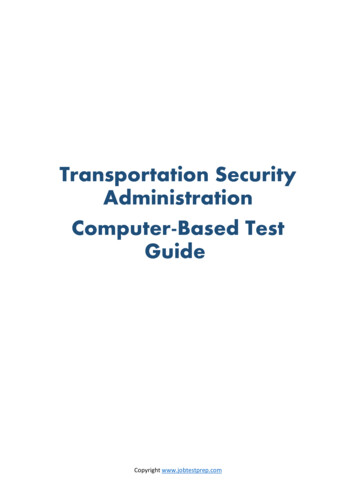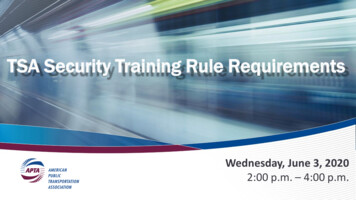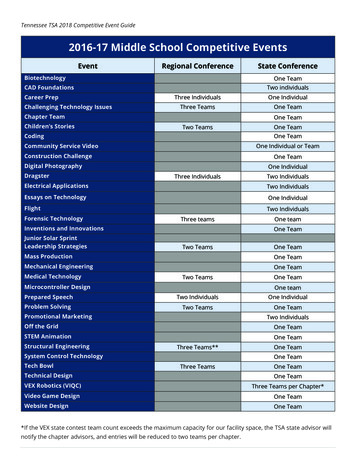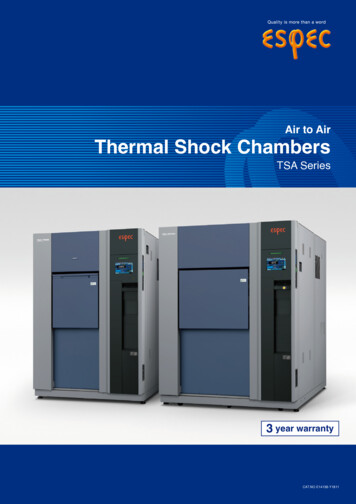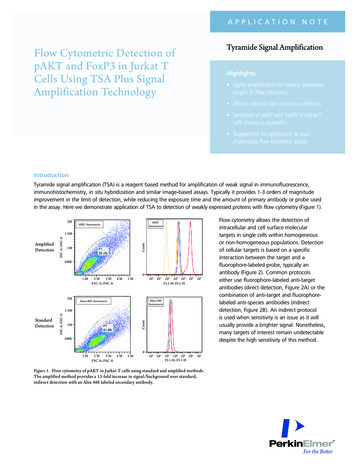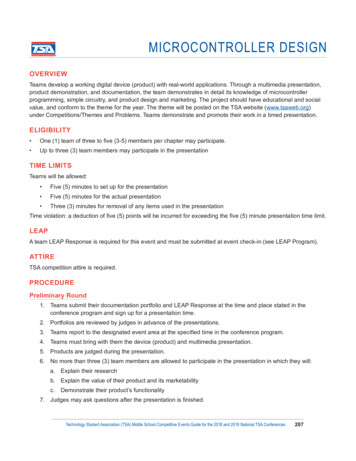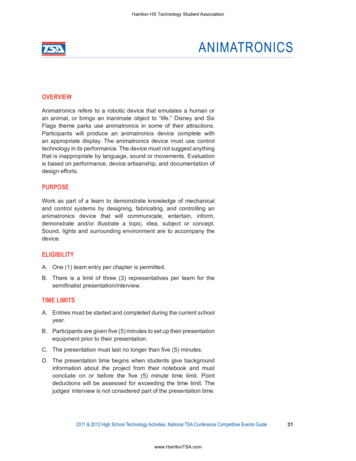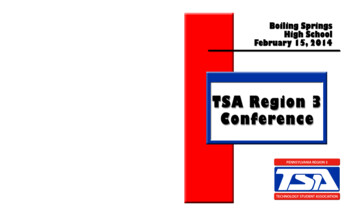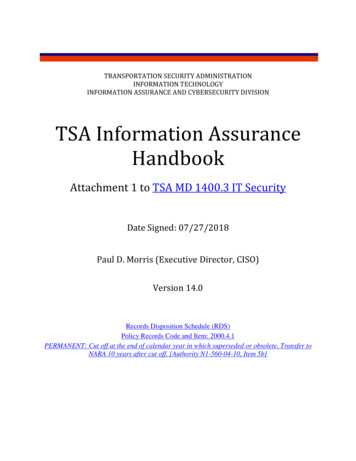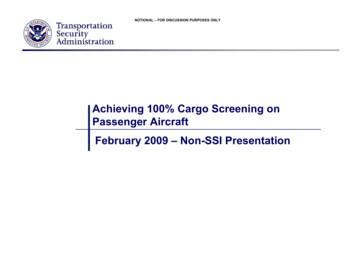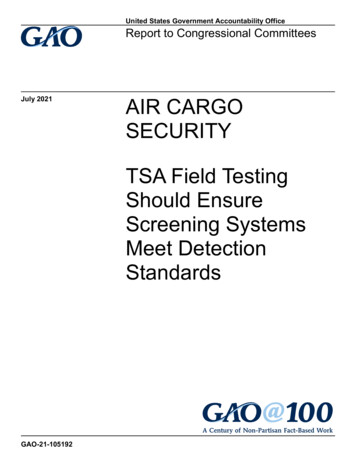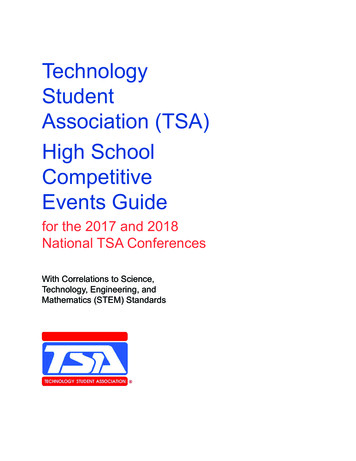
Transcription
TechnologyStudentAssociation (TSA)High SchoolCompetitiveEvents Guidefor the 2017 and 2018National TSA ConferencesWith Correlations to Science,Technology, Engineering, andMathematics (STEM) Standards
COPYRIGHT 2016—Technology Student AssociationEleventh EditionAll rights reserved. This guide was developed by the TSA CompetitionRegulations Committee and sanctioned by the TSA, Inc. Board ofDirectors. Unless otherwise indicated in this guide, no part may bereproduced in any form or by any means without written permissionfrom the executive director of the Technology Student Association.For more information, please contact theTechnology Student Association1914 Association DriveReston, VA 20191-1540phone 703.860.9000toll free 888.860.9010fax 703.758.4852general@tsaweb.orgwww.tsaweb.org
CONTENTSACKNOWLEDGMENTS . . . . . . . . . . . . . . . . . . . . . . . . . . . . . . . . . . . . . . . . . . . . . . . . . . viTSA, THE ORGANIZATION . . . . . . . . . . . . . . . . . . . . . . . . . . . . . . . . . . . . . . . . . . . . . . . viiTSA, Inc. Mission . . . . . . . . . . . . . . . . . . . . . . . . . . . . . . . . . . . . . . . . . . . . . . . . . . . viiiTSA Mission . . . . . . . . . . . . . . . . . . . . . . . . . . . . . . . . . . . . . . . . . . . . . . . . . . . . . . . viiiThe Role of Competitive Events . . . . . . . . . . . . . . . . . . . . . . . . . . . . . . . . . . . . . . . . viiiCOMPETITIVE EVENTS PROGRAM . . . . . . . . . . . . . . . . . . . . . . . . . . . . . . . . . . . . . . . . 1Levels of Competition . . . . . . . . . . . . . . . . . . . . . . . . . . . . . . . . . . . . . . . . . . . . . . . . . 1General Rules and Regulations . . . . . . . . . . . . . . . . . . . . . . . . . . . . . . . . . . . . . . . . . 1The Official TSA Competitive Event Rating Form/Rubric . . . . . . . . . . . . . . . . . . . . . . 4National TSA Dress Code . . . . . . . . . . . . . . . . . . . . . . . . . . . . . . . . . . . . . . . . . . . . . . 5Competition Regulations Committee . . . . . . . . . . . . . . . . . . . . . . . . . . . . . . . . . . . . . 6Rules Interpretation Panel . . . . . . . . . . . . . . . . . . . . . . . . . . . . . . . . . . . . . . . . . . . . . 6Event Coordinators . . . . . . . . . . . . . . . . . . . . . . . . . . . . . . . . . . . . . . . . . . . . . . . . . . . 7Awards . . . . . . . . . . . . . . . . . . . . . . . . . . . . . . . . . . . . . . . . . . . . . . . . . . . . . . . . . . . . 7SCIENCE, TECHNOLOGY, ENGINEERING, AND MATHEMATICS(STEM) INTEGRATION . . . . . . . . . . . . . . . . . . . . . . . . . . . . . . . . . . . . . . . . . . . . . . . . . . . 8Science Content Standards (Grades 9-12) . . . . . . . . . . . . . . . . . . . . . . . . . . . . . . . . 12Technology Content Standards . . . . . . . . . . . . . . . . . . . . . . . . . . . . . . . . . . . . . . . . . 14Criteria for Accrediting Engineering Programs (ABET, Inc.) . . . . . . . . . . . . . . . . . . . 16Principles and Standards for School Mathematics . . . . . . . . . . . . . . . . . . . . . . . . . . 19TSA AND CAREERS . . . . . . . . . . . . . . . . . . . . . . . . . . . . . . . . . . . . . . . . . . . . . . . . . . . . 20The Career Clusters . . . . . . . . . . . . . . . . . . . . . . . . . . . . . . . . . . . . . . . . . . . . . . . . . 20TSA Competitions and the Career Clusters . . . . . . . . . . . . . . . . . . . . . . . . . . . . . . . 23LEADERSHIP. EDUCATION. ACHIEVEMENT. PERSONAL GROWTH. (LEAP) . . . . . . 24
HIGH SCHOOL COMPETITIVE EVENTS . . . . . . . . . . . . . . . . . . . . . . . . . . . . . . . . . . . . 24Competitions . . . . . . . . . . . . . . . . . . . . . . . . . . . . . . . . . . . . . . . . . . . . . . . . . . . . . . . 25Competitive Events Eligibility . . . . . . . . . . . . . . . . . . . . . . . . . . . . . . . . . . . . . . . . . . 273D Animation . . . . . . . . . . . . . . . . . . . . . . . . . . . . . . . . . . . . . . . . . . . . . . . . . . . . . . . 28Animatronics . . . . . . . . . . . . . . . . . . . . . . . . . . . . . . . . . . . . . . . . . . . . . . . . . . . . . . . 39Architectural Design . . . . . . . . . . . . . . . . . . . . . . . . . . . . . . . . . . . . . . . . . . . . . . . . . 52Biotechnology Design . . . . . . . . . . . . . . . . . . . . . . . . . . . . . . . . . . . . . . . . . . . . . . . . 66Chapter Team . . . . . . . . . . . . . . . . . . . . . . . . . . . . . . . . . . . . . . . . . . . . . . . . . . . . . . 78Children’s Stories . . . . . . . . . . . . . . . . . . . . . . . . . . . . . . . . . . . . . . . . . . . . . . . . . . . 95Coding . . . . . . . . . . . . . . . . . . . . . . . . . . . . . . . . . . . . . . . . . . . . . . . . . . . . . . . . . . . 109Computer-Aided Design (CAD), Architecture . . . . . . . . . . . . . . . . . . . . . . . . . . . . . 120Computer-Aided Design (CAD), Engineering . . . . . . . . . . . . . . . . . . . . . . . . . . . . . 131Computer Integrated Manufacturing (CIM) . . . . . . . . . . . . . . . . . . . . . . . . . . . . . . . 142Debating Technological Issues . . . . . . . . . . . . . . . . . . . . . . . . . . . . . . . . . . . . . . . . 156Digital Video Production . . . . . . . . . . . . . . . . . . . . . . . . . . . . . . . . . . . . . . . . . . . . . 170Dragster Design . . . . . . . . . . . . . . . . . . . . . . . . . . . . . . . . . . . . . . . . . . . . . . . . . . . 184Engineering Design . . . . . . . . . . . . . . . . . . . . . . . . . . . . . . . . . . . . . . . . . . . . . . . . . 197Essays on Technology . . . . . . . . . . . . . . . . . . . . . . . . . . . . . . . . . . . . . . . . . . . . . . 209Extemporaneous Speech . . . . . . . . . . . . . . . . . . . . . . . . . . . . . . . . . . . . . . . . . . . . 219Fashion Design and Technology . . . . . . . . . . . . . . . . . . . . . . . . . . . . . . . . . . . . . . . 229Flight Endurance . . . . . . . . . . . . . . . . . . . . . . . . . . . . . . . . . . . . . . . . . . . . . . . . . . . 240Future Technology Teacher . . . . . . . . . . . . . . . . . . . . . . . . . . . . . . . . . . . . . . . . . . . 251Music Production . . . . . . . . . . . . . . . . . . . . . . . . . . . . . . . . . . . . . . . . . . . . . . . . . . 263On Demand Video . . . . . . . . . . . . . . . . . . . . . . . . . . . . . . . . . . . . . . . . . . . . . . . . . . 277Photographic Technology . . . . . . . . . . . . . . . . . . . . . . . . . . . . . . . . . . . . . . . . . . . . 289Prepared Presentation . . . . . . . . . . . . . . . . . . . . . . . . . . . . . . . . . . . . . . . . . . . . . . 303Promotional Design . . . . . . . . . . . . . . . . . . . . . . . . . . . . . . . . . . . . . . . . . . . . . . . . . 314Scientific Visualization (SciVis) . . . . . . . . . . . . . . . . . . . . . . . . . . . . . . . . . . . . . . . . 327Software Development . . . . . . . . . . . . . . . . . . . . . . . . . . . . . . . . . . . . . . . . . . . . . . 341STEM Careers . . . . . . . . . . . . . . . . . . . . . . . . . . . . . . . . . . . . . . . . . . . . . . . . . . . . 353
Structural Design and Engineering . . . . . . . . . . . . . . . . . . . . . . . . . . . . . . . . . . . . . 362System Control Technology . . . . . . . . . . . . . . . . . . . . . . . . . . . . . . . . . . . . . . . . . . 377Technology Bowl . . . . . . . . . . . . . . . . . . . . . . . . . . . . . . . . . . . . . . . . . . . . . . . . . . . 388Technology Problem Solving . . . . . . . . . . . . . . . . . . . . . . . . . . . . . . . . . . . . . . . . . . 401Transportation Modeling . . . . . . . . . . . . . . . . . . . . . . . . . . . . . . . . . . . . . . . . . . . . . 411Video Game Design . . . . . . . . . . . . . . . . . . . . . . . . . . . . . . . . . . . . . . . . . . . . . . . . 421Webmaster . . . . . . . . . . . . . . . . . . . . . . . . . . . . . . . . . . . . . . . . . . . . . . . . . . . . . . . 433FORMS APPENDIX . . . . . . . . . . . . . . . . . . . . . . . . . . . . . . . . . . . . . . . . . . . . . . . . . . . . 446
ACKNOWLEDGMENTSTSA is grateful to many people for their advice and expertise indeveloping the competitive events program over the years. Weespecially appreciate the volunteer efforts of the managers of theCompetition Regulations Committee (CRC), noted below, who havewritten and refined the event specifications that appear in this guide.Bob Behnke, TexasFrank D. Calfee, TennesseeLeigh Davis, TennesseeHal Harrison, South CarolinaAmanda Hodges, TennesseeLaura Hummell, PennsylvaniaJeff Lathom, PennsylvaniaEmily McAdams, North CarolinaDale Moll, PennsylvaniaNatalie Norman, North CarolinaSteve Price, GeorgiaSid Rader, VirginiaTony Raymond, ColoradoTara Royal, TexasAndy Stephenson, VirginiaMatt Walton, VirginiaBud Worley, TexasviTechnology Student Association (TSA) High School Competitive Events Guide for the 2017 and 2018 National TSA Conferences
TSA, THE ORGANIZATIONThe Technology Student Association (TSA) is a national organizationof students engaged in science, technology, engineering, andmathematics (STEM). Open to students enrolled in or who havecompleted technology education courses, TSA’s membershipincludes over 245,000 middle and high school students inapproximately 2,000 schools spanning 49 states. TSA is supportedby educators, parents, and business leaders who believe in theneed for a technologically literate society. Members learn throughchallenging competitive events, leadership opportunities, andmembership activities. From engineers to business managers, ouralumni credit TSA with having a positive influence on their lives.Explore what TSA has to offer by using this guide and by visitingwww.tsaweb.org for information. With competitive events that rangefrom video game design to software development and much more,there is something to capture the imagination of and bring out thebest in all students. We hope, that with teacher guidance, studentswill enjoy the challenge of TSA’s competitive events at local, state,regional, and national TSA conferences.The competitions in this guide support a broad spectrum of goalsrelated to science, technology, engineering, and mathematics(STEM) curriculum, as well as a focus on future career choices.R For moreinformation aboutbecoming a TSAmember, visitwww.tsaweb.org andclick on Join TSA,or call TSA’s toll freenumber, 888/860-9010.Technology Student Association (TSA) High School Competitive Events Guide for the 2017 and 2018 National TSA Conferencesvii
TSA, The OrganizationTSA, INC. MISSIONThe mission of the Technology Student Association, Inc. is to provideleadership and support to TSA through educational programs andservices.TSA MISSIONR Each competitiveevent has an eventmanager and acoordinator whoare responsible foranswering questionsabout the event’sguidelines. Managerand coordinator namesand contact informationcan be found on theTSA website atwww.tsaweb.org underDirectory/CompetitionRegulationsCommittee.The Technology Student Association fosters personal growth,leadership, and opportunities in Science, Technology, Engineering,and Mathematics (STEM); members apply and integrate theseconcepts through co-curricular activities, competitions, and relatedprograms.THE ROLE OF COMPETITIVE EVENTSTo embrace its mission, TSA offers competitive events, as well asrecognition in both STEM and leadership arenas. TSA believes thatby participating in carefully designed competitions, students learn todo their best, thereby becoming “winners” whether or not they placein a competition. Many teachers find that TSA’s competitive eventsprovide an excellent motivational tool in the academic environment.Every two years TSA’s competitive events are reviewed and revisedby the Competition Regulations Committee (CRC), a standing groupof technology educators with hands-on classroom experience. TheTechnology Student Association (TSA) High School CompetitiveEvents Guide for the 2017 and 2018 National TSA Conferencesis the result of the work of the CRC managers, competitive eventcoordinators, teachers, and the proposals of numerous TSA stateand chapter advisors, as well as students whose suggestions makeTSA competitions current and dynamic. The guide presents rulesand regulations for all national TSA conference competitive events,as well as a comprehensive view of each event’s connection toSTEM standards. Additionally, connections to career clusters andsuggested careers are featured for each event. Relevant for all levelsof competition (state delegations may choose to adopt the nationalguidelines for state-level competitions), the guide is a complementto curricular activities in the classroom.Thank you for your interest in TSA and your support of its programs.Rosanne T. White, Ed.D.TSA Executive DirectorviiiTechnology Student Association (TSA) High School Competitive Events Guide for the 2017 and 2018 National TSA Conferences
COMPETITIVE EVENTS PROGRAMLEVELS OF COMPETITIONA. The breakdown of grades noted below is used to designatecategories for curricular event entries. Each category level hasits own unique competitive events guide.Middle School/Junior High School: Grades 6, 7, 8, and 9High School: Grades 9, 10, 11, and 12Ninth graders must compete at the level in which their chapteraffiliates. For example, if the ninth grade is housed in a 9-12high school, students must compete in high school events.If the ninth grade is housed in a 6-9 or 7-9 school, ninth gradestudents must compete in middle school events.B. If the school has a K-12 configuration, or a configuration otherthan the examples above, contact national TSA for clarificationand approval regarding the appropriate school designation.GENERAL RULES AND REGULATIONSA. It is the intent of TSA to involve as many members as possiblein competitive events and provide recognition in a setting of fairplay practices using TSA event guidelines.B. Other than for the VEX event, TSA members, advisors, andchapters must be currently affiliated with TSA in order to enterany competitive event.C. TSA membership rights extend through the year of graduation.It is permissible for students who graduate midyear to competeat the national conference that immediately follows their end-ofyear graduation.D. Students must be registered and be in attendance with an adultchaperone at the national conference in order to enter andbecome a finalist in any event.E. It is the individual responsibility of each participant to obtain allrules and guidelines for competitive events. Lack of knowledgeor understanding about a particular event is neither reasonnor excuse for an individual to request an accommodatingadjustment or change.Technology Student Association (TSA) High School Competitive Events Guide for the 2017 and 2018 National TSA Conferences1
Competitive Events ProgramF.R General Rulesapply to all competitiveevents and are inaddition to eachevent’s specificguidelines.It is essential that students and advisors routinely check theTSA website www.tsaweb.org for updated information aboutTSA general rules and competitive events. This information isfound on the website under Competitions/Competition Updates.When students participate in any TSA competitive event, theyare responsible for knowing of all updates and changes relatedto that event.G. The TSA competitive event limit is six (6) per conferenceparticipant, individual and team events combined.H. Team members in an event must be affiliated with the samechapter. To enter a team event, the chapter designates only thatit is participating; names of the individual team members arenot necessary. Unless otherwise designated in a competition’seligibility guideline, the maximum size of a team is six (6)members.I.Entries (projects and/or products) may be submitted for one (1)year, and one (1) competition, only. An infraction of this rule resultsin disqualification.J.For all entries that require documentation, materials (comprisinga “portfolio”) must be secured in a clear front report cover; visitthis site for a sample report cover.K. Entries must be started and completed during the current schoolyear. All entries must be in English. Unless otherwise specified,no identifying information—other than an ID#—is to be includedon an entry. Exceptions to this rule are those events that requirecontent aligned with a school or community; such an exceptionwill be noted in the guidelines for specific events.L. Unless otherwise noted, for all events that require a display, thesize of the display may not exceed 15" deep x 3' wide x 4' high.R Visit this site(http://mlaformat.org)—just one of many—to learn about MLAstyle.2M. Participants must provide—and bring to the test site—two (2)pencils (sharpened standard #2/HB grade with an eraser, or #2mechanical with an eraser) for any competition that involvesthe use of a pencil (e.g., for taking a written test, for producingrequired sketches).N. For all applicable competitive events, citations or referencesmust follow Modern Language Association (MLA) style.O. All entries must be the original work of the student participantor student team. All ideas, text, images, and sound from othersources must be cited. If copyrighted material is used, properwritten permission must be included. Failure to follow thisprocedure results in disqualification.Technology Student Association (TSA) High School Competitive Events Guide for the 2017 and 2018 National TSA Conferences
Competitive Events ProgramP. All competitive events with a semifinalist component will have aminimum of twelve (12) semifinalists. Semifinalists (individualsor teams, as applicable) will compete against one another todetermine the top ten (10) finalists in an event. The decisions ofjudges related to competitive events are final.Q. Students must check in and pick up their event entries atthe times and places noted in the conference program, or asannounced at the national TSA conference.R. TSA is not responsible or liable for any personal property,equipment, or materials brought to a national TSA conferencefor use by a participant or attendee.S. When a conference event scheduling conflict could prevent anindividual from participating in an event, the individual has theright to decide which event is eliminated.T.During a conference, should a documented emergency arise ina team event that involves written and semifinalist segments,team member substitution may be allowed if approved by theevent manager and coordinator.U. All events are judged in accordance with the stated eventcriteria as noted in this competitive events guide. Concernabout any event during the national TSA conference should besubmitted in writing to the Rules Interpretation Panel (RIP) at theconference. The RIP will render a decision at the conference.The decisions of the RIP at the national conference are final.(For more information, refer to the Rules Interpretation Panelsection at the end of this guide.)R An Internetsearch aboutcopyrighted materialsand copyright fair useis recommended ifideas, text, images,or sound fromother sources areincorporated into anevent entry.For information aboutthe use of TSA’s logo,go to the TSA websiteat www.tsaweb.org/Trademark-Policies.V. Hazardous materials, chemicals, lighted or open flames,combustibles, wet cell batteries, and other similar substancesare not allowed at the national TSA conference. Competitionentries or presentations by participants must not include racialor ethnic slurs/symbols; reference to gang affiliation; or vulgar,violent, subversive, or sexually suggestive language or images.In addition, entries or presentations should not promote productsthat students may not legally buy, such as tobacco, alcohol, orillegal drugs. Images of guns, knives, or other weapons arediscouraged and may be cause for disqualification.W. Recording devices are not allowed at conferences in certaincompetitive events. CRC manager and event coordinatorapproval is required before any event may be recorded.Technology Student Association (TSA) High School Competitive Events Guide for the 2017 and 2018 National TSA Conferences3
Competitive Events ProgramX. Out of courtesy to other conference competitors and to avoidany perception of impropriety, no electronic communicationdevices of any kind are permitted during competition. Cellphones, iPads/tablets, electronic readers, etc., must be turnedoff.R Rule (Y)highlights what hasalways been true –student participantsmust be in attendancefor the duration ofthe national TSAconference.Y. Anyone who wishes to attend the national TSA conferencemust complete conference registration. All adult advisors,chaperones, and student participants must be in attendance forthe duration of the conference.Z. National TSA provides guidelines for student and team entrycontent, but it does not bear responsibility for content choicesmade by participants. Entries are evaluated on the basis of theevent’s official rating form.AA. Rules violations and disqualifications: A rules violation that givesa conference contestant an unfair advantage will result in atwenty percent (20%) deduction of the total possible pointsfor an event. The manager of an event also has the right todisqualify a contestant when this type of incident occurs. Theevent manager must sign off on both a twenty percent (20%)deduction and a disqualification.AB. TSA may choose to keep national TSA conference student entries.Such entries may be used by nationalTSAfor promotional purposes.Should that occur, credit for any such entry would be noted by TSA.The 2017 & 2018 High School Technology Activities, NationalTSA Conference Competitive Events Guide contains a ratingform/rubric for each competition. Rubrics have been embracedby STEM educators because they provide a clear way toevaluate subjective assessments. The use of descriptors(minimal, adequate, and exemplary) for each criterion beingmeasured in rubrics allows them to impart consistency andgreater understanding to the evaluation process.THE OFFICIAL TSA COMPETITIVE EVENT RATING FORM/RUBRICThe TSA rating form/rubric adds universal rigor and relevance toTSA’s competitive events, addresses the desire of students to havequality feedback about their performance in these events, andprovides a way for TSA members to better prepare for competitions,for advisors to carefully assist them in the process, and for judges toeffectively evaluate participants and their entries with consistency.4Technology Student Association (TSA) High School Competitive Events Guide for the 2017 and 2018 National TSA Conferences
Competitive Events ProgramNATIONAL TSA DRESS CODEChapter and state advisors, parents, and chaperones are responsiblefor seeing that all TSA student members wear TSA competition,general session, or casual attire as occasions may require. TSAattire may be purchased online via the SHOP tab on the TSA websiteat www.tsaweb.org. TSA competition, general session, and casualattire are considered appropriate dress for conference activities andpublic appearances. Because adults (advisors, parents, and guests)serve as role models at TSA conferences and activities, they areexpected to dress appropriately for all TSA occasions they attend.Students must adhere to the TSA dress code requirements as listedbelow. During general sessions at a national TSA conference, studentmembers must wear competition or general session TSA attire.Adults must dress appropriately. No flip flops, halter tops, tanktops, or shorts are permitted for anyone at general sessions.R Buying TSAapparel is a click awayon the TSA website atwww.tsaweb.org. Justclick on the SHOPtab to purchase TSAofficial attire, as wellas TSA hoodies, poloshirts and much more! When students compete in any competitive event they must wearcompetition attire. For Chapter Team only, at both the middleschool and high school levels, competitors also must wear a navyblue blazer with an official TSA patch; males (only) must wear theofficial TSA logo neck tie. Students not in appropriate competition attire when they competemay be allowed to participate in an event, but they will losetwenty percent (20%) of the total possible competition points.COMPETITION ATTIREShirt or blouse: official TSA shirt (royal blue)Pants or skirt: graySocks: black or dark blue (males only)Shoes: black dress shoes (unacceptable: athletic shoes, armyboots, combat, or work boots)Sandals: females only may wear black open-toe shoes or sandalsRequired for the middle school or high school level ChapterTeam event only, but may be worn for other competitions ifpreferred by contestant:Blazer: navy blue with official TSA patchTie: scarlet red imprinted with official TSA logo (males only)GENERAL SESSION ATTIREShirt or blouse: button-up shirt with a turned down collar or a polo/golf shirt; however, the official TSA shirt (royal blue) is preferredDress skirt or pants: gray (unacceptable: jeans, baggy pants,exterior pocket pants, shorts)Technology Student Association (TSA) High School Competitive Events Guide for the 2017 and 2018 National TSA Conferences5
Competitive Events ProgramSocks: black or dark blueShoes: dress shoes or dress boots (unacceptable: athletic shoes,combat, or work boots); females only may wear open-toe shoesor sandalsCASUAL ATTIREThe same as general session attire, OR appropriate t-shirts,shorts, or jeans.National TSA conference registrants must wearconference identification badges at all times.R The CRCis composed ofdedicated technologyteachers and educationprofessionals fromacross the countrywho have made majorcommitments to createand maintain the highquality of nationalTSA’s competitiveevents. See who theyare by clicking“TSA Directory” onthe nationalTSA website atwww.tsaweb.org.COMPETITION REGULATIONS COMMITTEEThe Competition Regulations Committee (CRC) is charged withreviewing TSA’s competitive events, updating them as necessary,and presiding over the competitive events at the annual nationalTSA conference. Questions about specific events may be addressedto event coordinators or to event managers. Please refer to theTSA Directory on the TSA website at www.tsaweb.org for completecontact information.Ideas and feedback regarding events are always welcome. Thereare guidelines and forms at the end of this guide for proposing a newevent or for suggesting revisions to existing events.RULES INTERPRETATION PANELThe Rules Interpretation Panel (RIP), a group made up of at leastthree (3) CRC members, monitors and oversees the competitiveevents during the national TSA conference. The panel provides ameans by which advisors may express grievances and concernsabout on-site situations that pertain to events, and it ensurescontinuity from year to year for competitive event rules andregulations. RIP members will maintain a panel throughout nationalTSA conferences.Immediately following the initial contact of an individual with concernabout a rule, the RIP panel will meet to discuss and analyze thesituation. Depending upon the severity of the problem, the individualmay be asked to submit the grievance in writing, using the RulesInterpretation Panel Grievance form (see Forms Appendix). It is theintent of the panel to resolve all grievances at the conference with aresponse in writing to the advisor.6Technology Student Association (TSA) High School Competitive Events Guide for the 2017 and 2018 National TSA Conferences
Competitive Events ProgramEVENT COORDINATORSTSA is grateful for the work of its event coordinators, many of whomare teachers attending the conference with students from theirchapters.Competitive event coordinators are present for conference eventcheck-in and check-out if they are coordinating an event in whichthese activities take place. Generally speaking, “check-in” is on theevening of registration day, and “check-out” is held on the day beforethe awards ceremony. Tentative schedule information is availablebefore the conference on the TSA website.Event managers support coordinators as they supervise competitiveevents throughout the year and at national TSA conferences.AWARDSA. At the awards ceremony, up to ten (10) finalists in each event areidentified in random order and called to the stage for recognition.B. From those ten (10) finalists, first, second, and third placeawards are presented to the individual or team representative,as determined by each event.R Following theannual national TSAconference, theten (10) finalists inmiddle and high schoolcompetitions will beC. Rankings beyond third place are not announced at the awardsceremony.posted on the TSAD. A list of the ten (10) finalists only for each event is available onthe national TSA website shortly after the conference.www.tsaweb.orgwebsite. Visitshortly after theconference for thisinformation.Technology Student Association (TSA) High School Competitive Events Guide for the 2017 and 2018 National TSA Conferences7
SCIENCE, TECHNOLOGY,ENGINEERING, ANDMATHEMATICS (STEM)INTEGRATIONIn recent years, not only educators, but also political, civic, andindustry leaders have pushed for a greater emphasis on science,technology, engineering, and mathematics (STEM) education inour schools. These groups feel that in order for our nation to becompetitive, healthy, and vibrant, our young people must havecompetency in the 21st century skills afforded through the STEMfields. TSA promotes a vision of students literate in these fields, aswell, and believes that the competitions within this guide help makethat vision a reality.STEM education is not just the isolated and discreet acquisition ofknowledge and skills related to science, technology, engineering, andmathematics. Rather, STEM education demands the interweavingand application of these academic fields for the purpose ofcomprehending, communicating, and solving problems. Indeed, itis now commonly accepted that to understand (and apply) any oneof these STEM areas, one must, at the same time, have a graspof and apply the others. For example, to design and engineer withany degree of complexity, one also must be familiar with technology,mathematics, an
To embrace its mission, TSA offers competitive events, as well as recognition in both STEM and leadership arenas. TSA believes that by participating in carefully designed competitions, students learn to do their best, thereby becoming "winners" whether or not they place in a competition. Many teachers find that TSA's competitive events
